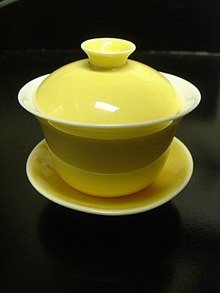Gaiwan
A Gaiwan ( Chinese 蓋碗 / 盖碗 , Pinyin gàiwǎn , Jyutping GOI 3 Wun 2 ) also known as Gaibei ( 蓋杯 / 盖杯 , gàibēi , Jyutping GOI 3 bui 1 ) or Juzhong ( 焗盅 , Juzhong , Jyutping guk 6 Zung 1 ), is a Chinese vessel for making and drinking tea . It consists of a saucer , a spherical bowl and a lid.
history
The Gaiwan evolved from a simple tea cup, the Chawan ( 茶碗 , cháwǎn , Jyutping caa 4 wun 2 ) in which poured the tea and from which it was drunk then. The Chawan is similar to the Matchawan used in the tea ceremony, in which Matcha is stirred. In the 9th century, master of ceremonies Lu Yu described the use of the simple chawan.
With the Ming Dynasty (1368 to 1644) the form of preparation changed: Instead of powdered tea leaves were scalded and the tea then poured off. The tea leaves were held back in the infusion vessel with the help of a lid for pouring. The preparation tools were so big that they had to be held with two hands. Today's gaiwan are smaller and can be used with one hand. Here the tea, especially green tea and white tea , does not have to be poured off. It can be drunk straight from the brewing bowl and brewed again.
use
As described, the Gaiwan can be used to drink the brewed tea straight from the bowl. In addition, the Gaiwan is also used as a pure brewing vessel as part of a tea ceremony .
The gaiwan is first rinsed with hot water to warm it up for preparation. Then the tea leaves are added, the water poured on and the lid put on. Depending on the type of tea and preparation method, the tea leaves may be “washed” by brewing them very briefly and then pouring off the water, sometimes several times.
At the end of the brewing time, the lid is placed at an angle so that a gap is created and the tea can flow out, but the leaves are held back. Usually the gaiwan is held in such a way that the thumb and middle finger touch the outermost edge while the index finger fixes the lid. The gaiwan is gripped from the side opposite the gap. Now the gaiwan is raised and the tea is poured into the preheated drinking cups through the gap. To do this, you usually use a tea table that is provided with holes to catch passing drops.
literature
- Lu Yu: The Classic of Tea . The Ecco Press, Hopewell 1995 (introduction and translation by F. R. Carpenter).
- Mary Lou Heiss and Robert J. Heiss: The Story of Tea: A Cultural History and Drinking Guide . Ten Speed Press 2007, ISBN 978-1-58008-745-2 , pp. 304 ff .

